When I just started learning about our mangrove plants, I had a hard time differentiating the various creepers and climbers found in our mangrove forest or other seashore habitats. Hence, thought I would just share over here the ones that I know how to identify. There are probably lots of species missing from this identification guide here, but hopefully as I explore more of our mangroves, I can slowly update this to make it more comprehensive. Hope those who need to quickly identify the coastal climbers will find this useful :)
To identify the plant, first ask the following questions in the following order and go to the respective section:
A) Does it appear leafless?
B) Is it a monocot?
C) Is it a dicot with compound leaves?
D) Is it a dicot with simple leaves?
A) Does it appear leafless?
1. The climber has no obvious leaves.

Love Vine (Cassytha filiformis) - This is a parasitic vine with tiny, scale-like leaves not more than 1mm big, and hence are not obvious to the naked eye. The species name "filiformis" means thread-like, refering to the thin and long stem of the climber, twining around and hanging from its host. It got its common name "Love Vine" as it was regarded as an aphrodisiac in some places. This plant actually can photosynthesize, and the young plant which has just germinated is green in colour and able to photosynthesize. The plant will aggressively twist about to seek a host, usually a beach shrub or tree, and on finding one, it will sink specialised structures called haustoria into the host's stem to retrieve nutrients and water. The plant eventually turns yellowish and become mostly dependent on the host for nutrients, and it's original roots in the ground will soon die off. If they could not find a host, the young plants will die off. The flowers are tiny and occur in small bunches. The small fruits are usually dispersed by birds.
B) Is it a monocot?
That is, it generally has parallel veins, and you can peel off each leaf with the leaf sheath (like the leaves of grass)?
2. It has big, glossy leaves, and some leaves terminate with a pitcher at the tip.

Raffles' Pitcher Plant (Nepenthes rafflesiana) - This is the biggest species of pitcher plant in Singapore. This species has 2 types of pitchers - the lower pitchers are short and fat, while the upper pitchers are tall and slender. Like other pitcher plants, the sweet nectar produced inside the pitcher attracts insects which fall into it, and the slippery walls of the pitcher will prevent the prey from escaping. The prey will then be broken down and absorbed. As pitcher plants can get nutritional supplements from their prey, they are hence able to survive growing on poor soil in sandy and rocky areas, including areas in the back mangrove. Pitcher plants are sometimes also called "Monkey Cups", as monkeys have been observed drinking rainwater from the pitchers.
3. The leaves are not glossy, with tendrils at the tips.
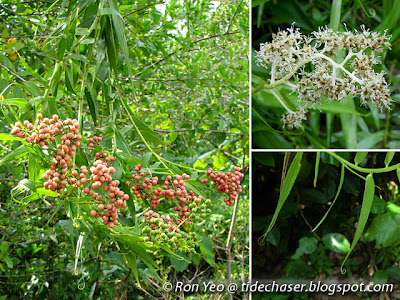
Rotan Tikus (Flagellaria indica) - Commonly found in swamp forest and back mangroves, the stem of this climber is sometimes used to be weaved into baskets, but it is not a durable as those made from rattan. "Tikus" means "rat" in Malay, but it is not sure how it got this common name. The flowers are white, occuring in clusters, while the fruits are round shiny berries, either pink or orange in colour when ripe.
4. It has compound leaves, and thick stems covered with spines.

Rotan Bakau (Calamus erinaceus) - Also called the Mangrove Rattan, this climber with numerous spines on the stem and at the tip of the leaves usually occur in the landward margins of mangroves or along tidal rivers. The flower occur in branching bunches, while the fruits are small and round. The inner part of the stem is occasionally used to make canes to be weaved into furniture or baskets, but it generally has little commercial use compared to the inland forest species as it is too stiff and hard.
C) Does it have compound leaves?
C1) It has only 3 leaflets.
5. Leaflets have toothed edges.
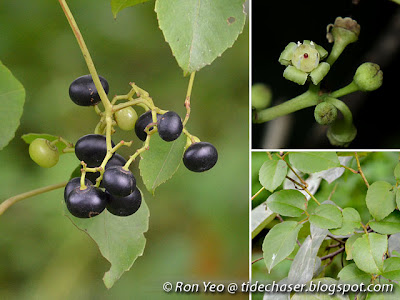
Bush Grape (Cayratia trifolia) - This climber is closely related to grapes, and black edible fruits, though personally I have not tried eating them before. It is commonly found climbing onto trees and shrubs at the back mangroves and coastal forests. It has tendrils growing on the opposite side of the leaf, which helps it to cling on to other plants. The small flowers occur in bunches. This plant is used traditionally to treat diabetes and snake bites.
6. The fleshy leaflets generally have rounded/blunt tips. Flowers are purple.

Bay Bean (Canavalia rosea) - This is one of the commonest creeper in the tropics! It is also called Kacang Laut in Malay - "kacang" means bean, and "laut" means "sea", hence meaning beans of the sea, an appropriate name since it is mostly found near the sea on sandy or rocky beaches. The young pods and seeds are edible after prolonged boiling in order to destroy the mild toxins in the plant. This creeper is also planted on eroding shores as a ground cover to crop to hold together the substrate.
7. The fleshy leaflets have pointed tips. Flowers are purple.
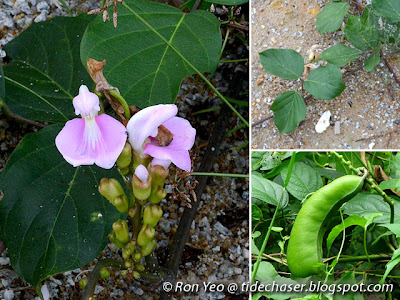
Maunaloa (Canavalia cathartica) - This common seashore plant can be found as a mat-forming creeper on sandy or rocky shores, or as a climber in mangrove and beach forests. Studies shown the beans to be highly nutritional, and scientists are exploring the possibility of exploiting it as a solution for food scarcity in developing countries. However, like most other Canavalia species, it contains mild toxins. Hence, in order for it to be safely consumed, they are usually soaked overnight to support microbial fermentation to break down the toxins, and then boiled or roasted.
8. The fleshy leaflets are tri-veined with slightly pointed tips. Flowers are yellow.

Beach Pea (Vigna marina) - Normally found in sandy or rocky beach areas, this creeper is quite salt tolerant. The seed pods are thinner have a bumpy appearance. This plant is used to treat wounds and ulcers. Like many other legume species, including the Canavalia spp., they host nitrogen-fixing bacteria, and hence increase the nitrogen content in the soil and helps other plants in the vicinity to grow better.
C2) It has 3, 5 or more leaflets with rounded tips.
9. It has palmately compound leaves with 4-6 elliptic or somewhat ellilptic leaflets that are not more than 1.5 times as long as broad.
To identify the plant, first ask the following questions in the following order and go to the respective section:
A) Does it appear leafless?
B) Is it a monocot?
C) Is it a dicot with compound leaves?
D) Is it a dicot with simple leaves?
A) Does it appear leafless?
1. The climber has no obvious leaves.

Love Vine (Cassytha filiformis) - This is a parasitic vine with tiny, scale-like leaves not more than 1mm big, and hence are not obvious to the naked eye. The species name "filiformis" means thread-like, refering to the thin and long stem of the climber, twining around and hanging from its host. It got its common name "Love Vine" as it was regarded as an aphrodisiac in some places. This plant actually can photosynthesize, and the young plant which has just germinated is green in colour and able to photosynthesize. The plant will aggressively twist about to seek a host, usually a beach shrub or tree, and on finding one, it will sink specialised structures called haustoria into the host's stem to retrieve nutrients and water. The plant eventually turns yellowish and become mostly dependent on the host for nutrients, and it's original roots in the ground will soon die off. If they could not find a host, the young plants will die off. The flowers are tiny and occur in small bunches. The small fruits are usually dispersed by birds.
B) Is it a monocot?
That is, it generally has parallel veins, and you can peel off each leaf with the leaf sheath (like the leaves of grass)?
2. It has big, glossy leaves, and some leaves terminate with a pitcher at the tip.

Raffles' Pitcher Plant (Nepenthes rafflesiana) - This is the biggest species of pitcher plant in Singapore. This species has 2 types of pitchers - the lower pitchers are short and fat, while the upper pitchers are tall and slender. Like other pitcher plants, the sweet nectar produced inside the pitcher attracts insects which fall into it, and the slippery walls of the pitcher will prevent the prey from escaping. The prey will then be broken down and absorbed. As pitcher plants can get nutritional supplements from their prey, they are hence able to survive growing on poor soil in sandy and rocky areas, including areas in the back mangrove. Pitcher plants are sometimes also called "Monkey Cups", as monkeys have been observed drinking rainwater from the pitchers.
3. The leaves are not glossy, with tendrils at the tips.

Rotan Tikus (Flagellaria indica) - Commonly found in swamp forest and back mangroves, the stem of this climber is sometimes used to be weaved into baskets, but it is not a durable as those made from rattan. "Tikus" means "rat" in Malay, but it is not sure how it got this common name. The flowers are white, occuring in clusters, while the fruits are round shiny berries, either pink or orange in colour when ripe.
4. It has compound leaves, and thick stems covered with spines.

Rotan Bakau (Calamus erinaceus) - Also called the Mangrove Rattan, this climber with numerous spines on the stem and at the tip of the leaves usually occur in the landward margins of mangroves or along tidal rivers. The flower occur in branching bunches, while the fruits are small and round. The inner part of the stem is occasionally used to make canes to be weaved into furniture or baskets, but it generally has little commercial use compared to the inland forest species as it is too stiff and hard.
C) Does it have compound leaves?
C1) It has only 3 leaflets.
5. Leaflets have toothed edges.

Bush Grape (Cayratia trifolia) - This climber is closely related to grapes, and black edible fruits, though personally I have not tried eating them before. It is commonly found climbing onto trees and shrubs at the back mangroves and coastal forests. It has tendrils growing on the opposite side of the leaf, which helps it to cling on to other plants. The small flowers occur in bunches. This plant is used traditionally to treat diabetes and snake bites.
6. The fleshy leaflets generally have rounded/blunt tips. Flowers are purple.

Bay Bean (Canavalia rosea) - This is one of the commonest creeper in the tropics! It is also called Kacang Laut in Malay - "kacang" means bean, and "laut" means "sea", hence meaning beans of the sea, an appropriate name since it is mostly found near the sea on sandy or rocky beaches. The young pods and seeds are edible after prolonged boiling in order to destroy the mild toxins in the plant. This creeper is also planted on eroding shores as a ground cover to crop to hold together the substrate.
7. The fleshy leaflets have pointed tips. Flowers are purple.

Maunaloa (Canavalia cathartica) - This common seashore plant can be found as a mat-forming creeper on sandy or rocky shores, or as a climber in mangrove and beach forests. Studies shown the beans to be highly nutritional, and scientists are exploring the possibility of exploiting it as a solution for food scarcity in developing countries. However, like most other Canavalia species, it contains mild toxins. Hence, in order for it to be safely consumed, they are usually soaked overnight to support microbial fermentation to break down the toxins, and then boiled or roasted.
8. The fleshy leaflets are tri-veined with slightly pointed tips. Flowers are yellow.

Beach Pea (Vigna marina) - Normally found in sandy or rocky beach areas, this creeper is quite salt tolerant. The seed pods are thinner have a bumpy appearance. This plant is used to treat wounds and ulcers. Like many other legume species, including the Canavalia spp., they host nitrogen-fixing bacteria, and hence increase the nitrogen content in the soil and helps other plants in the vicinity to grow better.
C2) It has 3, 5 or more leaflets with rounded tips.
9. It has palmately compound leaves with 4-6 elliptic or somewhat ellilptic leaflets that are not more than 1.5 times as long as broad.

Climbing Umbrella Plant (Schefflera elliptica) - This epiphytic plant occurs either as a straggling shrub or woody climber. I have only seen it growing on mangrove associates at the back mangroves so far, but not on true mangrove trees in Singapore. The flowers occur in clusters with some branches as long as or shorter than the elongated main axis. Each flower is very small. The small fruits usually splitting into 5-6 parts, turning from yellow or orange to black.
10. The leaflets are arranged alternately.

Dalbergia (Dalbergia candenatensis) - This climber usually occurs on the landward margins of mangroves or along tidal rivers. The small white flowers form clusters, and the seed pods are crescent shaped. This plant is used by tribal people in the region to treat boils or illness after childbirth.
11. The leaflets are arranged oppositely.

Crab's Eye (Abrus precatorius) - This climber is believed to be an exotic species introduced to Singapore, but I decided to add it here since I have seen it in many of our mangrove and coastal forests. The attractive seeds are hard and shiny red with a black patch, making them very popular for tribal jewelry. The raw seeds, however, contain abrin, one of the most poisonous plant toxins known. Despite that, boiled seeds have consumed as a contraceptive and an aphrodisiac by tribal people. These seeds, called Rati in India, have also been used from ancient times to weigh gold as each seed weighs about 1 carat each.
C3) It has 3, 5 or more leaflets with pointed tips.
12. The leaflets are ovate with obvious drip tips. Secondary veins are not obvious. Numerous lenticels on stem.

Mangrove Derris (Derris trifoliata) - This is a very common woody climber in the mangroves, especially on the landward side. The thick stem have numerous lenticels (believed to be for air exchanges) and twine around trees. The pale pink flowers occur in clusters, and the pods are oblong, somewhat rounded and flat. This plant is poisonous, and pounded leaves and roots are used to stun fish, and also as an insecticide. The poison will be broken down after cooking. This fishing method, however, is not encouraged as it harms not just the fish the fishermen want, but other animals in the area as well.
13. Leaflets are small (less than 3cm) and elliptic with no obvious drip tip and secondary veins. Numerous lenticels on stem.

Sea Derris (Derris scandens) - This critically endangered woody climber is sometimes found at the back mangroves or at the edge of beach forests. Sometimes, they can form thick layers draping over the trees, and young plants may occur as creepers before they find a support. It has delicate white flowers that occur in clusters, and the seed pods are oblong, longish and flat. Juice from the stem is also used as a fish poison, but is not as potent as the Mangrove Derris.
14. Leaflets are broadly (more than 5cm) ovate with obvious secondary veins. No obvious lenticels on stem.

Omis-omis (Aganope heptaphylla) - This critically endangered climbing shrub occurs in mangrove swamps and other coastal forest. It is sometimes found further inland, and mostly nearer to coastal areas. It has white flowers in clusters, and long seed pods. The young leaves are eaten as a vegetable.
15. There are several thorns on the stem, leaves are twice divided (bipinnate), with 2-6 pairs of primary leaflets divided into secondary leaflets.

Fever Nut (Caesalpinia crista) - This mangrove climber produces pretty yellow bunches of flowers, and is commonly found nearer to the back end of mangrove forests. It got its common name from that fact that it is used to treat fever, including those caused by malaria. It is also used to treat parasitic worms. The seed pods are elliptic and flat. The seeds are about 2cm big and up to 1cm thick, and are used to children to play marbles.
16. The stem is covered by numerous prickly thorns of different sizes. Leaves are twice divided (bipinnate), with 6-11 pairs of primary leaflets divided into secondary leaflets.

Grey Nicker (Caesalpinia bonduc) - This locally critically endangered climber got its common name from its grey and round seeds, which are used by children in the region for marbles. There are only 3 known plants in Singapore, one of which was found by me at Punggol Beach. The yellow flowers occur in clusters, while the seed pods are covered in prickly thorns. The seeds are dispersed by water, and studies shown they remain viable over long periods of time. This plant is sometimes planted as a hedge plant, and the numerous prickly thorns helps to deter unwanted intruders. It usually occurs at sandier areas of mangroves or at the back of sandy beaches.
D) Does it have simple leaves?
D1) It has alternate leaves.
17. It is a climber with alternate leaves. The leafing stem has a zigzag appearance.

Smythea lanceata - This nationally critically endangered climber can be found at the back mangroves or in coastal forest. The flowers occur in small clusters, and each flower has a funnel-shaped calyx tube covered with short hair on the outside. The petals are greenish yellow in colour. The fruit is ovate and laterally compressed, blending nicely with the leaves and often has the remains of the style at its tip.
18. It is a creeper with narrow fleshy alternate leaves. Tiny white hairs can be found in the axils of the leaves.

Kiss Me Quick (Portulaca pilosa) - I have no idea what gives it its common name, though the flower of the reddish variety does look a little like lips applied with brightly-coloured lipsticks, waiting to be kissed! The fruits are capsule-like and surrounded by white hairs. This creeping herb is nationally critically endangered in Singapore. When I was younger, I used to see it at Punggol and Loyang, but now, wild ones are only found on some of Singapore's southern islands and Pulau Ubin. The variety on the southern islands has yellow flowers, while the ones on Pulau Ubin are reddish pink. This creeping herb usually grows on rocky or sandy shores. Young plants are cooked and eaten. It is commonly cultivated as an ornamental plant.
D2) It has fleshy opposite leaves.
19. It is a creeper with small narrow opposite leaves.

Sea Purslane (Sesuvium portulacastrum) - This succulent creeping herb has reddish stem and pink flowers. Fruits are capsule-like, round and smooth. They are commonly found at the landward side of mangroves, and on sandy and rocky beaches. This plant is edible after repeated washing and boiling to remove the salt. It is also used to feed pigs, sheep and cattle.
20. The leaves are broad, thick and fleshy, coming in two forms - small and round, or long and pouch-like.

Ant Plant (Dischidia major) - This climber is commonly found in our mangrove and coastal forests. The long and pouch-like leaves are hollow with a hole on top, allow it to gather water and debris, which the plant can tap into for additional nutrients by growing roots into the chamber. Ants are known to nest in these chambers, and they brought with them more organic debris. Hence, the relationship is mutual, as both parties benefit. The flowers are yellow striped with green. The leaves exude a white and milky sap when broken.
21. The fleshy leaves are broadly oval, may have rounded or pointed tips.
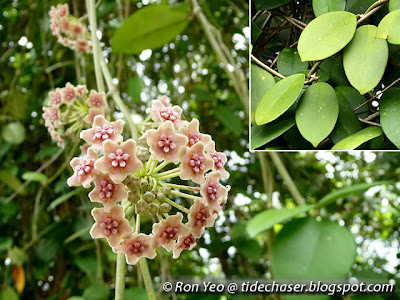
Wax Flower (Hoya diversifolia) - This nationally critically endangered climber has pinkish flowers in a bunch. The pretty flowers make it very popular with plant enthusiasts, and it is sometimes planted as an ornamental plant. The thin and long fruits usually occur in pair or alone. The leaves exude a white and milky sap when broken.
22. The fleshy leaves are narrower and elliptic with a pointed tip.
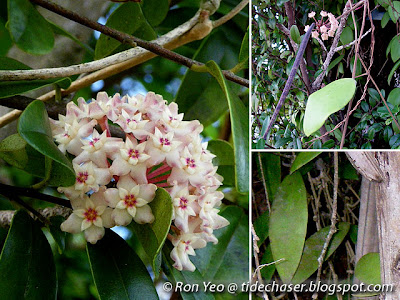
Wax Flower (Hoya verticillata) - This climber has white flowers with a reddish centre, flowering in a bunch. The pretty flowers make it very popular with plant enthusiasts, and it is sometimes planted as an ornamental plant. The thin and long fruits usually occur in pair or alone. The leaves exude a white and milky sap when broken.
D3) It has leathery or papery opposite leaves, and woody and firm main stem.
23. The thorns occur in hook-like pairs at the leaf node.

Akar Berdara Laut (Oxyceros longiflorus) - This semi-woody climber is often found at the back mangroves. The inverted hook-like thorns allow it to latch onto other plants as it climbs. In fact, the genus "Oxyceros" means "opposite horns". As the climber grows, new branches extend almost perpendicularly to the main stem, and this helps to hang on to other plants for support also. The flowers are white initially, but turn yellow as they mature. Fruits are small and round.
24. Leaf underside is whitish, and leaf edge is usually wavy.

Sonsong Harus (Combretum tetralophum) - This woody climber can be found in the back mangrove, coastal forest or even inland forest sometimes. The flowers have a furry appearance, occur at the ends of branches with new and smaller leaves. The fruit is ovoid with 4 wings. The seeds are used to treat internal worm infestations.
25. Leaf upperside is a dark glossy green, while underside is greenish to brownish. The leaf terminates with an obvious drip tip.

Gnetum microcarpum - This is a woody climber that is sometimes seen climbing on coastal trees. Like other Gnetum species, it is a gymnosperm which does not produce true flowers with petals, but instead, have male (right-top inset) and female (right-bottom inset) cones with unenclosed reproductive parts. The female cone has 8 ovules per collar, while the male cone has 20-30 filaments bearing pollen sacs at the tips. The female cone in the right-bottom inset has two developed seeds. They will eventually turn reddish, as shown in the middle-bottom inset. Apart from coastal forests, they can be found in inland primary forests as well.
26. Leaf underside is greensish. Young twigs are purplish or green, while old twigs are a light shiny brown.

Gambir Laut (Clerodendrum inerme) -This climber can also occur as a shrub, and is often found at the landward edges of mangrove forest or coastal forests. The flowers are white with purple or red stamens. Fruits are somewhat round, turning dark brown as they mature. Locals use the seeds and roots to treat seafood poisoning, and the leaves are used to treat wounds. It is sometimes planted as an ornamental plant for its pretty flowers too.
27. Leaf underside is greensish. Young twigs are greenish, while old twigs are a dark greyish brown. Leaves are narrowly elliptic.

Vomit Vine (Morinda umbellata) - This woody climber/shrub can be found at the landward edges of mangrove forest or coastal forests. The flowers are white, with numerous flower heads on long stalks at the end of a flowering branch. The small fruits are orange when they mature, and can be eaten. The roots can be used to produce a yellow dye.
28. Leaf underside is greenish. When exposed to the sun, the new stem is reddish, while the old stem is reddish brown. Otherwise, the stem may be dark green or brown. Leaves are broadly oblong or ovate. Broken leaves exude a watery sap.
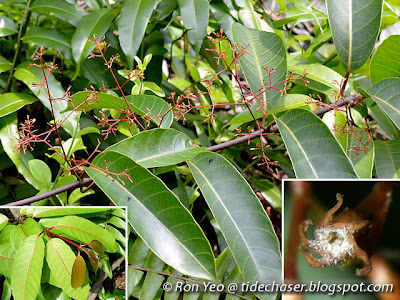
Anodendron candolleanum - This critically endangered woody climber occurs in coastal forests, and sometimes can be found climbing on trees on the beach. The tiny flowers occur in clusters.
D4) It has leathery or papery opposite leaves, and flexible and/or fleshy main stem.
29. Each leaf has 2 lobes.

Sea Morning Glory (Ipomoea pes-caprae) - This creeper is one of the commonest and most widely distributed salt-tolerant plant. The seeds are also salt-tolerant and are dispersed by sea water. It is an important sand stabiliser as it is often one of the pioneer species on a sandy beach and rocky shores. The leaf has 2 lobes, resembling a goat's foot, and hence it was also called commonly called Goat's Foot. In fact, "pes-caprae" means "goat's foot". The flowers are purple in colour, and fruits are round. The seeds are used to treat stomach complains, while the stem is used to treat bites and stings.
30. It has broadly heart-shaped leaves.
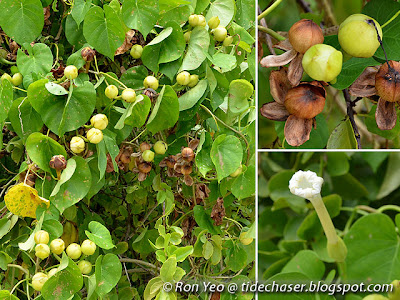
Beach Moonflower (Ipomoea violacea) - This climber occurs on sandy beaches and sometimes in the back mangroves. Interestingly, it is seldom seen on our shores, but more commonly seen inland, possibly because it is sometimes planted as an ornamental plant for its showy flowers. The flowers open at night, and hence the common name "moonflower". The colour of the flower may vary from white to purple or blue, and even pinkish red in some varieties. The fruit is a round capsule, with the enlarged sepals enclosing it like a cup, but as it matures and dries up, the sepals curl backwards. The dry capsule has 4 partitions, each with a seed. a fungi associated with this climber produces an alkaloid (closely related to the drug LSD), and hence this plant has been used for its hallucinogenic properties by tribal people to "communicate with spirits".
31. Leaf has toothed edge.

Sea Daisy (Melanthera biflora) - This straggling to climbing herb has lovely yellow composite flowers, and usually occurs on sandy beaches, mangrove edge and sometimes inland open area. The leaves have lots of medicinal properties, and are used to treat cuts, stings and ulcer. It can be consumed to treat stomach pains and to improve healing after childbirth.
32. Ovate leaves and reddish brown stem.

Maiden's Jealousy (Tristellateia australasiae) - This climber has pretty yellow flowers occurring in bunches, and hence the common name Maiden's Jealousy, as it is said that even a maiden will be jealous of its beauty. As a result, it is commonly planted in parks and gardens as an ornamental plant. In the wild, it occurs at the landward edges of mangrove forests, beach forests an along tidal rivers.
33. Narrowly heart-shaped or elliptic leaves with green stem.

Tylophora flexuosa - This climber can be found in the back mangrove and coastal forests. The leaves exude a clear sap when broken. Flowers are small, occurs in bunches with 5 reddish or purple petals and yellow centre. It's the host plant for the Blue Glassy Tiger butterfly.
34. Ovate leaves and green stem. Leaves are oriented in the same plane.

Psychotria sarmentosa - This nationally critically endangered plant is occasionally found in coastal forests and the landward margins of back mangroves, though it usually occurs in inland forests. The small flowers occur in clusters, while the fruits are small and round, turning from green to white with maturity.
35. Mature plants have oblong leaves, while young plants have long narrow leaves. Leaf veins are obvious with a much lighter colour.

Sea Rubber Vine (Gymnanthera oblonga) - This nationally critically endangered mangrove climber with greenish yellow flowers usually occurs at the edge of mangroves and open areas near the coast. The thin and long fruits usually come in pairs. The leaf exudes a milky sap when broken. The fruits are eaten in Papua New Guinea.
36. Mature plants have obovate leaves, while young plants or young shoots have narrowly lanceolate leaves. The leaf exudes a white milky sap when broken.

Kalak Kambing (Finlaysonia obovata) - While this climber/shrub is classified as critically endangered, I personally doubt this status as it occurs in too many places in Singapore. It is commonly found in mangrove forest at the landward side and along tidal rivers. The flowers can be purplish or greenish white in colour, as shown in the above photo which both varieties were climbing up the same tree. The fruits appear like a pair of horns, and hence the common name "kalak kambing", which means goat's horn. The young leaves are apparently eaten by some as a vegetable.
37. Leaves oval or egg-shaped. Leaves do not exude white sap when broken.

Sea Holly (Acanthus volubilis) - There are 3 species of Sea Hollies (Acanthus spp.) in Singapore. While all 3 species may occur as scrambling shrubby herbs, A. volubilis often occur as a climber when there are taller plants nearby to support it. The flowers are white, and the fruits are small nut-like capsules. Seeds of this plant are used in blood cleansing medicine and against ulcers.
References
- Chong, K. Y., H. T. W. Tan & R. T. Corlett, 2009. A Checklist of the Total Vascular Plant Flora of Singapore: Native, Naturalised and Cultivated Species. Raffles Museum of Biodiversity Research, National University of Singapore. Singapore. 273 pp.
- Giesen, W., S. Wulffraat, M. Zieren & L. Scholten. 2006. Mangrove guidebook for Southeast Asia. RAP Publication 2006/07. FAO Regional Office for Asia and the Pacific & Wetlands International. Bangkok. 769 pp.
- Ng, P. K. L. & N. Sivasothi. 1999. A guide to the mangroves of Singapore 1 : the ecosystem & plant diversity. Singapore Science Centre. Singapore. 168 pp.

No comments:
Post a Comment